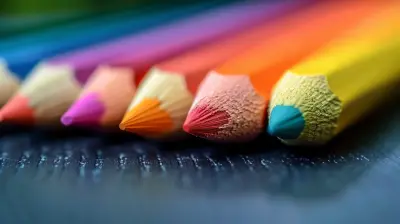Why Arts-Based Extracurriculars Matter in a STEM-Driven World
8 April 2025
Introduction
We live in a world where STEM (Science, Technology, Engineering, and Math) dominates conversations about future career paths. Society often pushes students toward coding boot camps, robotics competitions, and advanced math courses, emphasizing the ever-growing demand for tech-savvy professionals.
But what about the arts? Are they just a "nice-to-have" add-on? Absolutely not! Arts-based extracurriculars—whether it's music, painting, theater, or creative writing—play a crucial role in shaping well-rounded, innovative thinkers. In fact, they are just as valuable as STEM subjects in building essential life skills and fostering creativity.
Let's dive into why arts-based extracurriculars deserve a permanent place in our education system, even in a world obsessed with STEM. 
1. The Myth of STEM vs. Arts: Why Both Matter
There's a common misconception that STEM and the arts exist in separate worlds. People often believe that if you're a "math person," you can't be an "art person," and vice versa. But the reality? STEM and the arts are more intertwined than we realize.Think about it: Engineers design bridges, but they also need an artistic eye for aesthetics. Scientists conduct research, but they must communicate their findings through compelling visuals and storytelling. Even tech giants like Apple rely on design and creativity to make their products user-friendly.
The truth is, merging STEM with the arts—often called STEAM (Science, Technology, Engineering, Arts, and Mathematics)—creates a more balanced and innovative approach to learning. 
2. Creativity Fuels Innovation
Many people assume that creativity is only for musicians, painters, and writers. But in reality, creativity is the driving force behind some of the biggest technological advancements.Take Albert Einstein, for example. He was not only a brilliant physicist but also a talented violinist. He often credited his creative thinking in science to his love for music. Similarly, Steve Jobs famously drew inspiration from calligraphy to create Apple's sleek, user-friendly designs.
By engaging in arts-based extracurriculars, students develop the ability to think outside the box—an essential skill in any STEM field. 
3. Arts-Based Activities Improve Problem-Solving Skills
Ever tried to learn a musical instrument or perform in a play? It takes patience, perseverance, and problem-solving skills. When a musician struggles to master a difficult piece, they break it down, practice different techniques, and find creative ways to improve.This process mirrors what scientists and engineers do every day. Whether it's debugging a piece of code, designing a complex structure, or developing a medical breakthrough, problem-solving is key.
Students who participate in arts-based extracurriculars naturally develop resilience and adaptability—two qualities that are crucial in any STEM career. 
4. Emotional Intelligence and Communication Matter
STEM careers aren't just about crunching numbers and analyzing data. They require teamwork, collaboration, and strong communication skills—something the arts can nurture.Think about actors in a play; they need to express emotions, collaborate with fellow performers, and connect with an audience. Writers must craft compelling narratives that evoke emotions and engage readers. These skills are invaluable in the professional world, where clear communication can make or break a project.
Furthermore, arts-based activities help students develop emotional intelligence, allowing them to navigate complex social interactions, understand different perspectives, and build meaningful relationships—all essential skills for any career path.
5. The Arts Reduce Stress and Boost Mental Health
In the high-pressure world of STEM, students often experience burnout. Hours of problem-solving, coding, and studying equations can take a toll on mental health. This is where arts-based extracurriculars come in as a much-needed stress reliever.Painting, playing music, dancing, or writing poetry can serve as an emotional outlet, helping students manage anxiety and improve their overall well-being. Studies have shown that engaging in artistic activities lowers cortisol levels (the stress hormone) and boosts happiness by releasing dopamine.
When students have a creative escape, they're more likely to stay motivated and perform better in all areas of their education—including STEM subjects.
6. The Job Market Needs Creative Thinkers
Some argue that arts-based activities don’t provide "real world" skills, but the reality is quite the opposite. Employers today value creative problem-solvers who can think critically and adapt to changing technologies.Many industries rely on the arts—graphic design, UX/UI design, advertising, animation, film production, and even scientific visualization. Even in fields like artificial intelligence and machine learning, creativity plays a crucial role in developing user-friendly applications and ethical solutions.
As automation continues to replace repetitive jobs, creativity becomes one of the most sought-after skills in the workforce. Those with a balance of STEM knowledge and artistic creativity will have a competitive edge.
7. Arts-Based Learning Builds Confidence
Confidence is crucial for success in any field, and arts-based extracurriculars provide the perfect platform for students to develop it.Performing on stage, presenting artwork, or sharing original writing pieces requires courage and self-assurance. These experiences teach students how to handle constructive criticism, overcome stage fright, and express themselves confidently—skills that are beneficial in STEM careers, where presenting ideas and defending work is part of the job.
When students develop confidence in one area of their lives, it often spills over into others, including their academic and professional pursuits.
8. The Future is STEAM, Not Just STEM
As the world evolves, it's becoming clear that the most successful innovations happen when science and the arts work together. The growing recognition of STEAM (Science, Technology, Engineering, Arts, and Mathematics) highlights the importance of integrating creativity into traditional STEM fields.Many of today’s groundbreaking innovations—augmented reality, digital art, virtual reality, and even space exploration—rely on a combination of technical expertise and artistic vision. By encouraging students to engage in both STEM and the arts, we prepare them for a future that values well-rounded, creative problem solvers.
Conclusion
In a world driven by technology and science, arts-based extracurriculars remain more important than ever. They don’t just provide a fun escape from academics—they build essential skills like creativity, communication, problem-solving, and emotional intelligence that are critical in any career.So, instead of treating the arts as an afterthought, let's embrace them as a vital part of education. Whether a student wants to become a scientist, engineer, entrepreneur, or artist, engaging in creative activities will only enhance their journey.
At the end of the day, the most successful individuals are those who can think beyond formulas and algorithms—those who can innovate, imagine, and create. And that’s why arts-based extracurriculars matter in a STEM-driven world.
all images in this post were generated using AI tools
Category:
Extracurricular ActivitiesAuthor:

Eva Barker
Discussion
rate this article
6 comments
Xavi McAuley
Integrating arts with STEM fosters creativity and innovation, essential skills for tackling complex challenges in our evolving world.
April 27, 2025 at 9:00 PM

Eva Barker
Absolutely! Integrating arts with STEM not only enhances creativity but also equips students with innovative problem-solving skills vital for navigating today’s complex challenges.
Uriah Romero
Arts-based extracurriculars are essential in a STEM-focused environment as they foster creativity, critical thinking, and collaboration. These skills enhance problem-solving and innovation, bridging the gap between science and the arts. Integrating artistic pursuits cultivates well-rounded individuals, equipping them for diverse challenges in an increasingly complex, interdisciplinary world.
April 19, 2025 at 12:35 PM

Eva Barker
I completely agree! Integrating arts into STEM cultivates creativity and innovation, essential for tackling today’s complex challenges. It truly enriches education and prepares students for a multifaceted world.
Corinne McGinnis
Love this! Arts-based extracurriculars spark creativity and innovation, essential for a balanced, thriving STEM education. Great insights!
April 15, 2025 at 11:16 AM

Eva Barker
Thank you! I'm glad you found the insights valuable. Arts-based extracurriculars truly enrich STEM education by fostering creativity and innovation.
Karen Miller
In a STEM-centric landscape, arts-based extracurriculars aren’t just a luxury—they're essential. They foster creativity, critical thinking, and innovation, bridging gaps between logic and imagination. Embracing both worlds equips students for a future that demands versatility and vision.
April 9, 2025 at 2:58 AM

Eva Barker
Absolutely! Arts-based extracurriculars enrich STEM education by enhancing creativity and critical thinking, preparing students for a versatile future.
Juniper Jennings
This article beautifully highlights the crucial role of arts-based extracurriculars in a STEM-driven world. Integrating creativity with technical skills fosters innovation and critical thinking. By embracing the arts, we nurture well-rounded individuals who can approach problems from diverse perspectives, ultimately enriching both fields and driving meaningful progress. Keep inspiring!
April 8, 2025 at 8:16 PM

Eva Barker
Thank you for your thoughtful comment! I'm glad you resonated with the message about the importance of integrating the arts into STEM—it's essential for fostering innovation and a richer learning experience.
Ivan Snow
Who knew that adding a splash of paint to equations could actually solve the problem of boredom? Let’s keep nurturing creativity; after all, even robots need a little flair!
April 8, 2025 at 3:30 AM

Eva Barker
Absolutely! Integrating creativity into STEM not only makes learning fun but also fosters innovative thinking. Let's continue to blend art and science!
MORE POSTS

Flipped Classroom: Reducing Teacher Burnout by Shifting Focus

The Role of Parents in Standardized Test Preparation: Dos and Don’ts

Addressing the Needs of Gifted Learners: A Psychological Approach

The Role of Critical Thinking in Standardized Test Performance

Real-World Problem Solving with Project-Based Learning